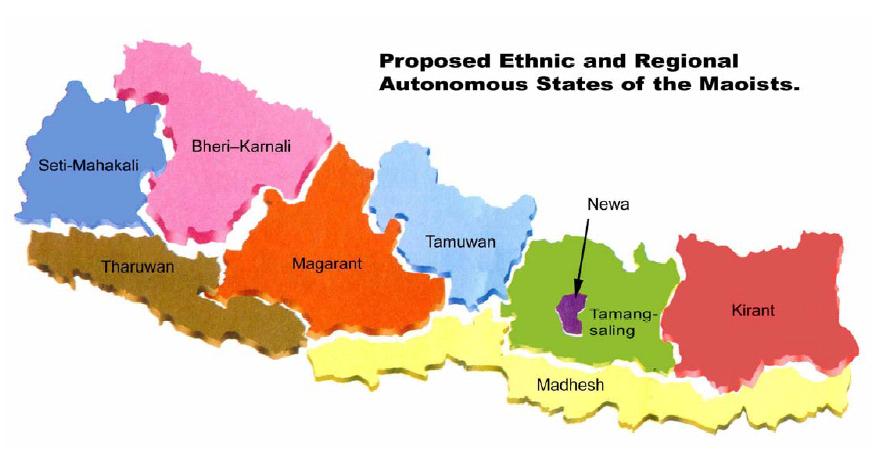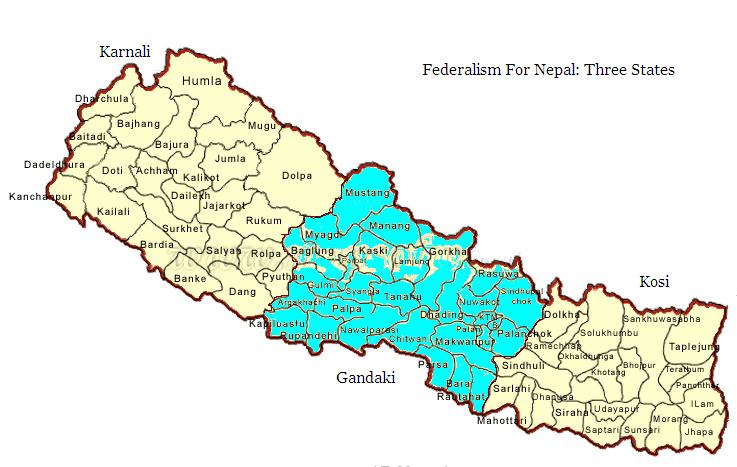
The current "zones" and "development regions" are to be abolished, but the "districts" are to be retained. The country is to be divided into three states, roughly of equal population, Eastern, Central, and Western, to be called Koshi, Gandaki, and Karnali, that are to include all three geographical regions, Terai, Pahad and Himal, and based on the three river basins. Each state is to have a Pratinidhi Sabha, 120 members, and a Rajya Sabha, 40 members. Each seat for the federal Pratinidhi Sabha is to be divided into two for the state Pratinidhi Sabha ............ The federal government will directly transfer 10% of its annual budget to the 25 poorest districts measured by per capita income. This does not prevent further federal expenditures on those districts. .......... The income tax structure is to be as follows: 50% federal, 30% state, 10% district, and 10% village/town/city. The income tax is to be collected by the federal government, and funds transferred by the same to the other levels of government as per this formula, and is to be gradually phased in where none might be getting collected now. ......... The federal revenue from all sources other than income tax is also to be similarly allocated. 50% stays at the federal level, the rest goes to the three states equally. Each state is also to send out 40% of its non income tax budget directly to the districts in direct proportion to the population of each district.
(Source: Proposed Constitution)
I have been proposing a three state federalism: Kosi, Gandaki, Karnali.
Interim Federalism
Federal Republic Guaranteed
Critiquing Pitambar Sharma's Federalism
Pitambar Sharma's Federalism
Federalism: Competing Maps
RPP For Federalism Ahead of UML, NC And NC(D)
My Federalism Is Economic, Scientific, Not Ethnic
Why It Is Important To Me The Congress Takes Up A Federal Republic
UML Inching Towards Federalism
Monarchy, Army, Federalism
The Maoists have put forth their map for federalism. The seven party alliance or its component parties do not have one yet. I urge the seven parties to come around to my map. It could also end up being the compromise map for the Maoists and the seven party alliance.

 I have been consistently vocal on Madhesi rights. I have been so vocal, it has earned me a place in the Madhesi Hall Of Fame. I have been put in the same league as people like Gajendra Narayan Singh, Ram Raja Prasad Singh, Udit Narayan Jha, Upendra Mahato, among others.
I have been consistently vocal on Madhesi rights. I have been so vocal, it has earned me a place in the Madhesi Hall Of Fame. I have been put in the same league as people like Gajendra Narayan Singh, Ram Raja Prasad Singh, Udit Narayan Jha, Upendra Mahato, among others.And I am under tremendous pressure to propose a federalism where the Madhesh is its own state. A lot of Madhesis I know actually like the Maoist map. I don't dislike it myself.
But I am thinking rapid economic growth when I am proposing an alternate map. Just like in the hills, poverty is the number one political issue in the Terai. I am cognizant of that fact. Nepal's economy is my number one concern.
My proposed federalism, just like my language policy, and my education policy are all guided by that basic premise, that Nepal's number one task is rapid economic growth. I have also tried to design a constitution that could have a near universal appeal. It should also make sense for other countries with slight modifications, especially for countries that have not yet had their democracy movements.
But my map is no patchwork, and it is no apology for being a Madhesi. I take fierce pride in my Madhesi heritage.
I think it will be a minor adminstrative nightmare to reorganize the 75 districts. My proposal is to leave them alone. I believe the real question on federalism and power devolution is how much power you will give the districts. The Maoists envision nine states, I envision 75 powerful districts. I envision 75 directly elected district chairpersons.
There are Madhesis who would like to see Madhesi Chief Ministers. I would like to see 16 Madhesi district chairpersons who command more than half the budget of all districts, and a 50-50 chance of there being a Madhesi Governor in each of the three states, and always a 50-50 chance of there being a Madhesi president at the center.
The 75 districts have not been drawn along ethnic lines, but if they were to be given enough power in terms of how big their budgets end up being, they will do better justice to Nepal's diversity than states drawn along ethnic lines.
If you adopt the Maoist map, I am seeing a future of water disputes between states. That is a big concern for me.
You have to design a federalism that allows for plentiful economic mobility for the citizens. Regardless of ethnicity, people should be able to move to any part of the country and feel just fine.
I think the biggest diversity challenge might be in the capital city itself. The city is a mini New York. You have people from all over Nepal there. How do you manage that diversity? The number one thing seems to be to make the economic opportunity plentiful.
Language Policy
Federalism and language rights are related questions. The number one issue there is how do you best teach science and maths to all kids nationwide. Language issues are secondary to that.
In The News
Finland provides Rs 1.9 billion grant assistance to Nepal govt NepalNews
Moriarty meets PM Koirala
Sitaula for arms management prior to interim govt
Arms management along with political issues: Maoists the government is violating agreements by raising the issue of rebels’ arms management leaving behind the political agenda. ...... made the decision to find consensus in some political issues of the interim constitution by holding the high level meeting between the top leaders of the ruling seven party alliance and the Maoists. ...... “We made the decision to take the ongoing peace talks to its logical end ...... “We will work seriously to take the ongoing talks to the logical end and give peaceful outlet to the Maoist insurgency
Maoists capture five people involved in 'looting' Maoists captured five people from Sankhu of Kathmandu, Thursday, allegedly involved in looting in the name of the rebels. .... They were made public at Maoist party office in Lalitpur on Friday. ..... They had tried to loot a passenger bus, which was also carrying a Maoist cultural group ...... The accused were handed over to the police on Friday.
Maoists not abiding by pacts: Sitaula the Maoists are not abiding by the ceasefire code of conduct and various agreements reached between the ruling seven party alliance and the Maoists. .... the government is adhering by all pacts. ..... “Although, the Maoist leadership has been frequently expressing their commitments to abide by the agreements, there have been ample instances of violations at the local level” ...... the upcoming summit talks would resolve all the differences between the government and the Maoists
RPP reviewing its stance on monarchy: RPP chief Rana "The RPP has begun informal discussions with the objectives of reviewing the party's stance on the monarchy and changing the party statute to suit the changed political scenario" ....... Rana said nobody disarms if one feels disarming will make him insecure. Security should be ensured to the Maoists if they wish to disarm.
Finalize interim constitution at the earliest: Nepal
Will the Maoists of Nepal ever disarm? Financial Express, India After 10 years of a bloody war and with 10,000 cadres killed, why would Maoists settle for a number three slot in Parliament, as opinion polls suggest? Aside from the regular 30,000 odd fighting force of the Maoist army, there are about the 100,000-strong militia which the Maoists have built up in the countryside, an “invisible” force that consists mainly of 14-18 year olds who help enforce the writ of the Maoists.Most of them carry some sort of weapons, ranging from crude knives country pistols, but they do not wear uniforms and do not necessarily take part in military activities. They assist the guerilla only when required and are mostly responsible for guarding villages under Maoist control. They are in effect the future recruits. The presence of this militia has created a pervasive fear in rural areas, and many experts see a parallel between current-day Nepal and Cambodia during the post-1979 period.
New formula to disarm Maoists
Now, Nepal Wants To Hear From King Gyanendra Shah
Nepal announces regular electricity power cuts due to low rainfall International Herald Tribune, France
India shoots down double bid by Nepal to get arms Telugu Portal, India
Russia Played Key Role in Secret Nepal Arms Deal — Report
NPC to publicise interim plan Kantipur Publications
Maoists form 10-member committee to speed up summit talks
HLPC mulling alternative ways to interrogate king
SEBS launches flood relief program
Two-and-half hours load-shedding from today
Eliminate fear of arms to hold CA elections: Sitaula
Maoists start party hospital
Maoists abduct hotelier, son
कांग्रेस कार्यकर्ताद्वारा गृहमन्त्रीसँग सुरक्षा माग
मन्त्री हुँदाको पछुतो संस्मरणमा
चेपाङको राष्ट्रिय साधारणसभा
नक्कली बाबुको नाममा नागरिकता
कानुनका आँखाबाट अन्तरिम संविधान
जातीय र भाषिक युद्ध
